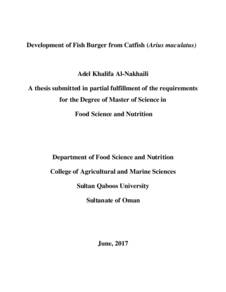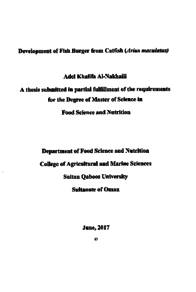Document
(Development of fish burger from catfish (Arius maculatus
Publisher
Sultan Qaboos University
Gregorian
2017
Language
English
Subject
English abstract
In Sultanate of Oman, there are plenty of fish species available, but people concentrate mainly in certain species for consumption. As a result, the demand of these species increased and at the same time their prices increased too. On the other hand, there are many underutilized fish species possess high nutritional value and available with rational prices but consumers do not consume them either because of their unpleasant aroma, their undesired taste or their unusual shape. However, if a technology is developed to get rid of the undesired aroma and shape, these species can be utilized and converted to value added products. Catfish, Arius maculatus, is one of underutilized fish species in the Sultanate that is available in abundant quantities with affordable price and most of its produce is exported as raw and cheap materials. So, the aim of this study was to develop a technology capable of utilizing underutilized fish such as catfish and converting it to a value-added product (fish burger) and studying its storage stability during 3 month of storage at - 18°C. Getting rid of the undesired aroma was accomplished by dipping the fillets of the fish in water and then with the use of mixture of spices with the aid of other ingredients like corn flour. Fresh catfish burger contained water, protein, total fat, total ash and carbohydrates as 70.53, 17.82, 1.04, 1.73, 8.89 g/100 g sample respectively. The total bacterial count decreased, from log 4.77 cfu/g in fresh burger to log 4.35 cfu/g after 3 months of storage. The water holding capacity and the peroxide value decreased significantly (p<0.05) from 90.7 % and 15.38 meq/kg fat in fresh fish burger to 83.46 % and 5.19 meq/kg fat, respectively, after 3 months of storage, but the water holding capacity of the cooked burger after 3 months of storage did not change significantly (p>0.05). The color values, L, a and b of the fish burger decreased significantly (p<0.05) after 3 months of storage from 47.69, -0.43 and 13.83 to 45.73, -1.48 and 12.66 respectively, whereas the L and b values decreased significantly (p<0.05) for the cooked burger after 3 months of storage from 43.46 and 14.24 to 39.05 and 13.24 respectively, but the a value increase from 1.12 to 1.45 was not significant (p>0.05). Texture profile analyzer (TPA) parameters of the fish burger namely, cohesiveness, chewiness and gumminess increased significantly (p<0.05) after 3 months of storage from 0.37, 5.19 and 5.19 to 0.47, 6.56 and 6.56, respectively, but adhesiveness decreased significantly (p<0.05) from -0.31 to -0.18. In contrast, hardness and elasticity did not change significantly (p>0.05) and decreased from 14.11 and 0.9999 in fresh burger to 13.94 and 0.9997 after 3 months of storage, respectively. On the other hand, adhesiveness was the only parameter of the cooked burger that changed significantly (p<0.05) and increased from -0.0001 in cooked fresh fish burger to -0.001 after 3 months of storage, but cohesiveness and elasticity did not change significantly (p>0.05) and decreased from 0.779 and 0.9999 in cooked fresh fish burger to 0.776 and 0.9997 after 3 months of storage, respectively. Hardness, chewiness and gumminess of the cooked fish burger did not change significantly (p>0.05) and increased from 43.24, 33.71 and 33.72 in the fresh cooked burger to 46.73, 36.23 and 36.25 after 3 months of storage, respectively. All the attributes of 9 points hedonic scale of sensory evaluation, namely, odor, color, taste, texture and general acceptability, of cooked fish burger did not change significantly (p>0.05) and all decreased from 7.3, 7.5, 7.2, 7.3 and 7.5 in the fresh fish burger to 7.0, 7.2, 6.5, 6.5 and 6.3 after 3 months of storage, respectively. This study developed a technology for underutilized fish species such as catfish in the Sultanate by converting it to a value added fish product, fish burger, which showed a good storage stability for 3 months at - 18°C. This study recommends to implement this technology using other types of underutilized fish in the Sultanate of Oman, like ribbonfish and extend the storage study period to evaluate the stability of its quality during frozen storage.
Member of
Resource URL
Arabic abstract
في سلطنة عمان، هنالك تنوع كبير في الأسماك المناسبة للانتها، إلا أن معظم المستهلكين يتجهون إلى أنواع محدد بعينها ونتيجة لذلك، زاد الطلب على هذه الأنواع، متبوعا بارتفاع في أسعار ها. من ناحية أخرى، هناك العديد من أنواع الأسماك غير المستغلة وذات القيمة الغذائية العالية والمتاحة بأسعار معقولة ولكن المستهلكين لا يقبلون عليها إما بسبب رائحتها المنفرة، أو الطعم غير المستساغ أو شكلها الغريب لكنه إذا تم التطوير للفية للتخلص من الروائح المنفرة او الشكل غير المرغوب فيها صباح استغلال هذه الأنواع وتحويلها إلى منتجات ذات قيمة مضافة و تو مردود قصادي جيد للسلطنة ويعتبر سمك الخن، أريوس ماكو الاوس)، أحد أنواع الأسماك غير المستغلة في السلطنة والتي تتواجد بكميات وفيرة وبأسعار رخيصة، ويتم تصليرا معظم ما يصاد منه گلمواد خام رخيصة الذا، هدفت هذه الدراسة إلى ايجاد تقنية قادرة على استخدام سمك الحن، كأحد أنواع الأسماك غير المستعلة، ومعالجته لإنتاج بزبر الساعث کنتج ذو قيمة مناقة ودراسة على اعتقاله بجولته خقل فترة التخزين المدة 3 أشهر من التجميد في حرارة - 18 درجة مئوية استطاعت الدراسة التخلص من الرائحة غير المرغوبة من سمك الخن
عن طريق غمس شرائح السمك في الماء و من ثم باستخدام خليط من التوابل مع مكونات أخرى مثل دقيق الذرة. وجدت الدراسة أن برجر سمك الخن الطازج احتوى على 70. 53 ، 17 . 82 ، 1 . 04 ، 1 . 73 و 9 . 89 جم/1100ء من الماء والبروتين والدهون الكلية و الرماد الكلى والكربوهيدرات على التوالي. تم تسجيل انخفاض العدد الكلي للبكتيريا، من (لو غارتيم) 4. 77cfug في برجر طازج إلى الو شمار انيم) 4. 35cfug بعد 3 أشهر من التخزين وانخفضت القدرة على الاحتفاظ بالماء وقيمة البيروكسيد الشكل ملحوظ من 90. 7 % و 15. 38meq / kg الن الدهون في برجر السمك الطازج إلى 83. 46 % و meg/ kg5 . 19 من الدهون على التوالي بعد 3 أشهر من التخزين. اما قدرة البرجر المطبوخ على الاحتفاظ بالماء بعد 3 أشهر من التخزين لم تتغير بشكل ملحوظ. ( 0 . 05 =p) وانخفضت قيم اللون Lو a و b في برجر السمك الطازج بشكل ملحوظP ( 0.05= ) بعد 3 أشهر من التخزين من 47. 69 - 430 و 13 . 83 إلى 45 . 73 و - 14812 .
66 على التوالي، في حين انخفضت قيم L ر ا بشكل ملحوظ. ( 0 . 05=p) للبرجر المطبوع بعد 3 أشهر من التخزين من 43. 46 و 1424 إلى 39
. 05 و 13 .24 على التوالي، ولكن الزيادة في قيمة 1 من 1. 12 إلى 1 . 45 لم تكن كبيرة تحليل محلات تنفط القوام البرجر السمك و تتمثل بوجه الخصوص التماساق، قوام المضغ و وقوام العلوكة أرتفعت بشكل ملحوظ ( 0. 05=P) بعد 3 أشهر من التخزين من 0. 37 و 519 و 5.19 إلى 047 و 6 . 56 و 6 . 56 على التوالي، ولكن قيم الالتصاق انخفضت بشكل ملحوظ ( 0. 05=p) من - 0. 31 إلى - 0 .18 . في المقابل، لم تخير الصاية و المرونة بشكل ملحوظ ( 0. 05<p) و انخفضت سن 14. 11 و 0 . 9999 في البرجر الطازج إلى 13. 94 و 00997 بعد 3 أشهر من التخزين، على التوالي. من ناحية أخرى، كان الالتصاق الخاصية الوحيدة للبرجر المطبوخ الذي تغيرت بشكل الحوط ( 0 . 05=p) و از داد من - 0 . 0001 في بزجر السمك الطازج المحليون إلى - 0.001 بعد 3 أشهر من التخزين، ولكن التماسك و المرونة لم تتغير بشكل كبير ( 0. 05 <p) وانخفضت من 0. 779 و 0 .
9999 في برجر السمك الطازج المطبوخ إلى 0 . 776 و 0 . 9997 بعد 3 أشهر من التخزين، على التوالي ولم تتغير نسبة ماتية وقوات المضغ و قوام العلوكة في برجر السوق المطبوخ بشكل ملحوظ ( 0. 05 =p) وزادات من 2443 و 33. 7233 . 71 في البرجر المطبوخ الطازج إلى 46. 73 و 36 23.
عن طريق غمس شرائح السمك في الماء و من ثم باستخدام خليط من التوابل مع مكونات أخرى مثل دقيق الذرة. وجدت الدراسة أن برجر سمك الخن الطازج احتوى على 70. 53 ، 17 . 82 ، 1 . 04 ، 1 . 73 و 9 . 89 جم/1100ء من الماء والبروتين والدهون الكلية و الرماد الكلى والكربوهيدرات على التوالي. تم تسجيل انخفاض العدد الكلي للبكتيريا، من (لو غارتيم) 4. 77cfug في برجر طازج إلى الو شمار انيم) 4. 35cfug بعد 3 أشهر من التخزين وانخفضت القدرة على الاحتفاظ بالماء وقيمة البيروكسيد الشكل ملحوظ من 90. 7 % و 15. 38meq / kg الن الدهون في برجر السمك الطازج إلى 83. 46 % و meg/ kg5 . 19 من الدهون على التوالي بعد 3 أشهر من التخزين. اما قدرة البرجر المطبوخ على الاحتفاظ بالماء بعد 3 أشهر من التخزين لم تتغير بشكل ملحوظ. ( 0 . 05 =p) وانخفضت قيم اللون Lو a و b في برجر السمك الطازج بشكل ملحوظP ( 0.05= ) بعد 3 أشهر من التخزين من 47. 69 - 430 و 13 . 83 إلى 45 . 73 و - 14812 .
66 على التوالي، في حين انخفضت قيم L ر ا بشكل ملحوظ. ( 0 . 05=p) للبرجر المطبوع بعد 3 أشهر من التخزين من 43. 46 و 1424 إلى 39
. 05 و 13 .24 على التوالي، ولكن الزيادة في قيمة 1 من 1. 12 إلى 1 . 45 لم تكن كبيرة تحليل محلات تنفط القوام البرجر السمك و تتمثل بوجه الخصوص التماساق، قوام المضغ و وقوام العلوكة أرتفعت بشكل ملحوظ ( 0. 05=P) بعد 3 أشهر من التخزين من 0. 37 و 519 و 5.19 إلى 047 و 6 . 56 و 6 . 56 على التوالي، ولكن قيم الالتصاق انخفضت بشكل ملحوظ ( 0. 05=p) من - 0. 31 إلى - 0 .18 . في المقابل، لم تخير الصاية و المرونة بشكل ملحوظ ( 0. 05<p) و انخفضت سن 14. 11 و 0 . 9999 في البرجر الطازج إلى 13. 94 و 00997 بعد 3 أشهر من التخزين، على التوالي. من ناحية أخرى، كان الالتصاق الخاصية الوحيدة للبرجر المطبوخ الذي تغيرت بشكل الحوط ( 0 . 05=p) و از داد من - 0 . 0001 في بزجر السمك الطازج المحليون إلى - 0.001 بعد 3 أشهر من التخزين، ولكن التماسك و المرونة لم تتغير بشكل كبير ( 0. 05 <p) وانخفضت من 0. 779 و 0 .
9999 في برجر السمك الطازج المطبوخ إلى 0 . 776 و 0 . 9997 بعد 3 أشهر من التخزين، على التوالي ولم تتغير نسبة ماتية وقوات المضغ و قوام العلوكة في برجر السوق المطبوخ بشكل ملحوظ ( 0. 05 =p) وزادات من 2443 و 33. 7233 . 71 في البرجر المطبوخ الطازج إلى 46. 73 و 36 23.
Category
Theses and Dissertations


